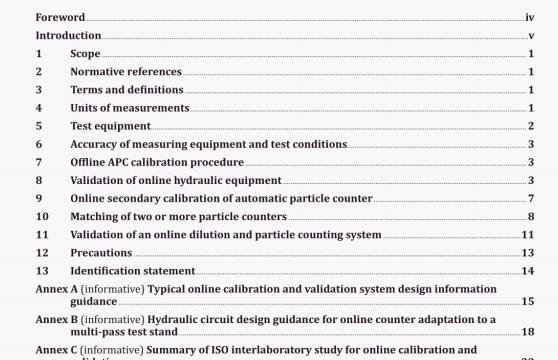ISO 11943 pdf download – Hydraulic fluid power – Onlineautomatic particle-counting systems for liquids – Methods of calibration and validation.
9.5 lf the particle counts obtained in 9.3 are outside the limits set, take corrective action and repeat the
verification procedure described In 2.1 through 2.4.
Ensure that:
a) the proper sensor flow rate Is being used;
b) the particle size threshold settings are correct;
c) the fluid is completely degassed;
d) the sample weights and volumes are correct;
e) if interpolation of threshold settings between verified points is required, the Iso 11171 method of Interpolation shall be used. xtrapolation may not be used.
10 Matching ol two or more particle counters
10.1 This procedure shall he used when two or more APCs are to be used upstream and downstream of a filter to measure its filtration efficiency at various sizes.
NOTE The ‘master’ system (sensor 1) in the matching process is the system with the higher signal to noise ratio. This allows the ‘slave’ sensor (sensor 2) a wider matching range
10.2 In itself, this procedure is not suited to performing or verifying the calibration of one of the two Instruments. For calibration refer to Clause 7: for online calibration refer to Clause 9.
10.3 Connect the ARC calibrated in accordance with CLause 9 (online calibration) and another one to be matched to the sampling points described in 5.5 of a closed loop system validated in accordance with Clause 8.
The two instruments shall match together without using the dilution system
10.4 Set the instruments to the cumulative mode and to at least six different threshold settings over the particle size range of interest.
10.5 Adjust total fluid volume, expressed in 1.. in the hydraulic test equipment to the desired level and measure within ii %. Maintain fluid viscosity at (15 * 2.0) mm2/s. The concentration of particles at any size should be statistically significant and particle counts should be at any sIze >10,
10.6 Circulate the fluid through the clean-up filter until the fluid contamination level is c S particles> 5 m(c)/L
10.7 Determine the ISO MTD concentration to be used for the matching so that the maximum particle count at the lowest particle size can be approximately 75 % of the ARC coincidence error limits determined in 7.2. Prepare in accordance with 5.3. Record the ISO MTI) batch/lot number
10.8 Bypass the clean-up filter, add the contaminant to the reservoir and mix by circulation for about 15 mm or until the counts have stabilized across the size range.
10.9 Start the ARC matching procedure by conducting online automatic counts at 1-mm intervals for a period of at least 30 mm.
EXAMPLE For a two times dilution factor (1 part diluent: 1 part suspension), use a sample concentration equal to 2 times 75% of the counter concentration limit.
11.6 Bypass the clean-up filter, add the contaminant to the reservoir and mix by circulation for about
15 mm or until the counts have stabilized across the size range, whichever occurs first.
11.7 Set the particle counter at a minimum of six particle size threshold settings covering the range of interest.
11.8 Using the dilution factor selected, obtain a minimum of three 25 mL particle counts (after the counts have been stabilized) for each sensor and calculate the average count of the diluted sample for each particle size.
11.9 Calculate the average counts per mL for each particle size threshold setting dividing the average count by the fluid volume counted in mL. Record the values in Table 6. Use separate data sheets for both sensors 1 and 2 where used.
11.10 All particle counts obtained in 11.7 should be equal to the reference counts, ± the calibration limits in column 3 of Table 3, for each particle size counted. In addition, when sensors 1 and 2 are being used the average counts from the two counters (sensors) shall agree within the allowable variation given in 10.10, for each particle size counted.
11.11 Repeat the procedures given in 11.4 to 11.10 at the maximum dilution factor to be used and at least two other intermediate dilution factors within the total dilution range of the system. It is recommended that the most common dilution ratios that will be used for the equipment be checked as described in this clause.
ISO 11943 pdf download – Hydraulic fluid power – Onlineautomatic particle-counting systems for liquids – Methods of calibration and validation
